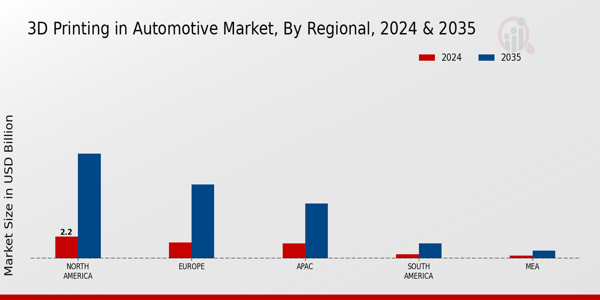The 3D Printing in Automotive Market is a dynamic and rapidly evolving sector that relies on advancements in additive manufacturing technology. This market encompasses a wide range of applications, including prototyping, tooling, and end-use parts production, which are transforming traditional automotive manufacturing processes.
As automation and customization demand increases, automotive companies are investing in 3D printing technologies to streamline production, reduce costs, and enhance design capabilities.
Competitive insights reveal that key players are leveraging innovative approaches to material science and machine efficiency, making significant strides in not only enhancing their product offerings but also in creating sustainable manufacturing processes.
Market competition is intensified by the emergence of new entrants and the continual improvement of existing technologies, positioning industry leaders to capitalize on various opportunities in this expanding market.
HP, a major player in the 3D Printing in Automotive Market, has established a strong presence with its advanced multi-jet fusion technology, enabling the production of high-quality automotive parts. The company's strengths lie in its diverse portfolio of 3D printing solutions that cater effectively to the needs of automotive manufacturers looking for speed and efficiency.
HP's additive manufacturing systems facilitate rapid prototyping and production scaling which increases their operational agility. Additionally, HP's robust ecosystem of materials and software ensures compatibility and ease of integration within existing automotive production lines.
Their commitment to innovation and sustainability bolsters their positioning as a trusted partner in the automotive sector, allowing companies to achieve faster time-to-market and reduced production costs while maintaining high-performance standards.
Renishaw, renowned for its expertise in precision engineering, has made significant inroads into the 3D Printing in Automotive Market with its metal additive manufacturing systems. The company focuses on delivering high-quality metal parts that serve critical automotive applications, emphasizing precision and reliability.
Renishaw’s strengths include its advanced technology platforms that support advanced materials and provide solutions tailored to meet the specific needs of automotive clients. Moreover, Renishaw actively engages in mergers and acquisitions to enhance its product offerings and expand its technological capabilities in the sector.
Their commitment to research and development ensures they remain at the forefront of innovation, addressing the growing demand for customized applications in the automotive industry.
With a strong focus on quality assurance and engineering excellence, Renishaw aims to strengthen its global market presence by providing comprehensive solutions that drive efficiency and performance in automotive manufacturing.






















Leave a Comment